Cecil James Turner (1888-1957)
Scoutmaster, 2nd Tewkesbury Scouts, 1910-1930
This article has been largely researched from a scrapbook compiled by C. J. Turner who left it to the safe keeping of Vernon Caudle one of his King’s Scouts who was associated with Scouting in Tewkesbury for over sixty years. It is now in the guardianship of his son Graham who has lent it to me, through the offices of David Willavoys. The Editor has added information from the Woodard Database in the footnotes.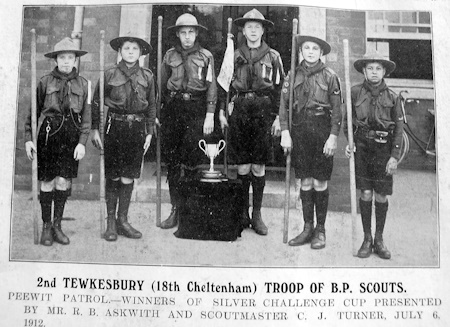
Image right: Turner also organised an annual day camp competition on Whit Monday[5] to determine the best patrol and the boys themselves voted for the best scout. Three patrols were the Kangaroos, Peewits and Swifts; much later the Beaver patrol was added. In these early years the troop routinely met at the Senior Council School [Chance Street].
On 10 May 1910 Turner met a group of boys in a local field wearing white haversacks and carrying poles. They invited him to their hut to have a cup of tea. They told him they were “Scouts”; the movement was still very new then, though there was a troop attached to the Abbey. W.E. Lane, who later lived in Kenya, invited Cecil James Turner to be their Scoutmaster.[2] After some hesitation he agreed. Subsequently they met at Turner’s home, 11 Church Street, where on 3 November, Turner and his troop made their promises to Rev. C.W. Dixon who was Scoutmaster and Chaplain to the recently formed 1st Tewkesbury attached to the Abbey.
This was always regarded as the official beginning of the troop as a member of the Baden Powell Scouts.[3] The Mayor and other dignitaries were present. Turner always ensured that the great and the good attended all major functions.
In the summer they had held two day camps at Brockeridge Common and Lincoln Lane. Mrs. Brierley of Southwick Park presented the troop with its colours dedicated by the Vicar, Rev. Canon Wardell-Yerburgh.
On 29 October 1910, what came to be called a ‘wide game’ was organised. Ten scouts from Upton-on-Severn attempted to deliver messages to Queen Margaret’s Camp. The defenders were scouts from 1st and 2nd Tewkesbury and Twyning. The ‘despatches’ were the size of two postage stamps and three Upton Scouts won through, one in a butcher’s cart which the defenders chose not to challenge; another in a cart, which was challenged and in which one scout was struck by a whip. Another hid it in his watch while a third concealed it in his shoe. Both were stopped but the guards did not discover the despatches within the allotted time. In a similar event the Church Lads Brigade [CLB] successfully defended Queen Margaret’s Camp though one scout reached within three yards before being stopped. Turner was a great organiser and many events were held. On 27 December 1910, a dance and whist drive were held in the Grammar School and in later years similar events were held in the Town Hall. On 25 January 1911 a ‘Scoutmasters party’ was held by the leaders, often called officers in those days, for the boys. As well as food there was dancing, singing and sketches. This post-Christmas party became a regular annual feature as did a concert to raise funds at the Watson Hall on 2 and 3 May, 1911. The concert was to raise money for the annual summer camp. Boys, leaders and friends took part.
Summer Camp was also a regular event. These were a little over a fortnight in length and were nearly always local. Among chosen sites over the years were Corse Lawn, Chaceley, Bushley and Nottingham Hill, Cleeve. The sites were invariably owned by a local worthy. A varied programme would include scout-craft, raiding games, swimming, bugles etc. They always invited the local village to a concert. At Chaceley they played a cricket match against the ‘cream of Chaceley’, which the scouts won 45 to 28. The camp normally closed with a slap-up tea provided by the landowner.
An exception to the normal summer camp came in 1912 when the District (Cheltenham) organised a Camp at Portishead, near Bristol. 135 scouts travelled by train including scouts from All Saints and St. Martins, Cheltenham, Charlton Kings, 2nd Tewkesbury and 1st and 2nd Campden. The weather was unkind but a varied programme of activities was followed involving the local troop, Nailsworth.
In 1913 a large rally of Scouts was organised at Bingley Hall, Birmingham, opened by HRH Princess Alexander of Teck[4] and attended by the Lord Mayor, the Chief Scout and Lady Baden Powell, the Bishop of Birmingham and sundry other VIPs. There were many exhibitions including craftsmanship, model making, aeroplanes, wireless installations, cooking, printing, athletic skills and many others. Both Tewkesbury troops participated, along with the Kemerton troop. Altogether some 30,000 scouts, many from overseas, were inspected by Prince Arthur of Connaught.[6] This was a forerunner of the International Jamboree. A camp was set up, in Perry Hill Park, Birmingham, and 1st Tewkesbury camped there.
Two church parades were noted in 1914. The first was a District parade at Alderton. Most cycled to Teddington Hands. There were boys from Alderton, Kemerton, Beckford, 2nd Tewkesbury, 3rd Cheltenham (Grammar School), 10th Cheltenham (All Saints) and 15th Cheltenham (St. James). After the parade, they enjoyed a “substantial tea”, provided by Sir Richard and Lady Martin.
The first record of a St. George’s Day parade was on 26 April 1914, when they marched for the first time to a non-conformist church, Highbury Congregational Church in Cheltenham: the 2nd Tewkesbury cycled there and back. They also joined in the Empire Day7 parade in May, with many other organisations including the CLB.
The annual camp for 1914 went ahead as planned in spite of the sudden and unexpected outbreak of war, at Sarn Hill, Bushley, under the leadership of Turner and Assistant Scoutmaster [ASM] Gregory and Scoutmaster [SM] Dutton of the Forthampton Troop. They swam in Bushley baths and paraded to church at Bushley and Forthampton. At a campfire they burned an effigy of the Kaiser [Emperor William II of Germany].
to Expand
Mr. Hewett, manager of the Royal Hop Pole Hotel, had been good to the Scouts allowing them the use of a club room for meetings. On leaving, he gave them a strawberry tea and a cricket set. Soon afterwards, the YMCA. gave the Scouts the use of Tolsey Hall; previously it was the Methodist Church until Collins’ new building had been opened in 1878. Henceforth 2nd Tewkesbury added ‘YMCA’ to its title and it remained their HQ until occupied by American troops in 1942.
to Expand
Image right: Turner served throughout the war and was not demobilised until April 1919: however, he had volunteered as a private soldier but ended the war as an officer. Not surprisingly, there are hardly any entries in Turner’s log between late 1914 and 1918.
Good relations with that Church Lads’ Brigade were strengthened in 1914 when the 1st Gloucestershire Battalion of the Regular Army travelled to Tewkesbury. They were met at the station by the 2nd Tewkesbury band who led 600 cadets to the Abbey and subsequently to ‘Workhouse Hill’,[8] where they were reviewed. 2nd Tewkesbury provided an Ambulance Tent and a sports programme.
Outbreak of war also witnessed the volunteering of scout leaders. 26-year-old Turner left as one of the ‘Abbey Boy’ volunteers in the 5th Gloucesters Battalion.[9]
However, the troop continued to function under, at various times, ASMs Green, Gregory and Howell, unlike 1st Tewkesbury which closed and was not restored until as late as 1931; it is now 3rd Tewkesbury and is no longer a sponsored group attached to the Abbey. Summer camps carried on during the war, and we have a brief account of the 1915 camp, again at Sarn Hill, which suffered heavy rain and 22 scouts slept in a large room provided by the owner.
At a ‘Patriotic Night’ at the Picture Playhouse on 14 October 1914, the scouts sang Be Prepared. They helped control the crowds when the first batch of Belgian refugees was accommodated in a specially fitted house in High Street.[10] They also helped to keep order when 36 wounded, of whom 26 were Belgians, were admitted to the Mit ton VAD Hospital[11] and the Watson Hall.
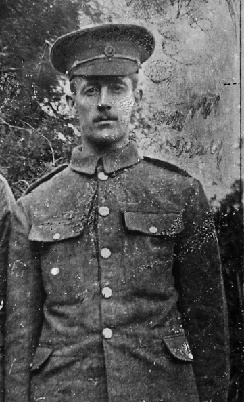
Image right: One tragic event in 1915 was a memorial service for 28 year-old Trooper W.G. Dutton, formerly Scout Master of the Forthampton Troop who we have seen attended their camp of 1914: he was killed at the Battle of Loos. He had volunteered for the Life Guards and was a member of the battalion’s Cyclist Company. As Trooper Dutton’s body was never recovered, he may well have been a victim of shelling. It is only his name that is commemorated on the Loos Memorial. He is also commemorated on the Tewkesbury Grammar School memorial, located now in the Town Hall.
The official Peace Celebrations were on Saturday 26 July 1919. The day before all the school children were given a free tea and the Mayor, Ald. Alfred Baker, visited each school. The town was decorated with buntings. Sadly it started to drizzle and by 5pm had become a downpour. The Mayor and officers paraded through the town followed by a fancy dress parade, but prizes were postponed till Monday when Turner’s scouts won a prize as Cowboys and Indians. A crazy cricket match survived the rain.
Summer Camp in 1919 was at Apperley, again under Turner with ASMs Green and Crisp, with Troop Leaders Lawrence as Quartermaster and Linnell as cook. They welcomed a large number of visitors on Sunday who came by river steamer, car and cycle. The campers were roused early one morning by a cottage fire: they formed chains to salvage what they could and brought buckets of water but still the roof collapsed.
a Boy-Scout in 1912 Click Image
to Expand
On Whit Monday 1920, the Scout Cup tests were held as before, in the Tolsey Hall as the weather was bad. The Kangaroos were the winning patrol under Patrol Leader Cook and the all-round best scout was Charles Titcombe.
The tenth anniversary of the first investiture occurred on 10 November. Turner reported that 80 boys passed through the troops. Many Vice-Presidents attended including the Mayor and Mrs. Strickland of Apperley Court, the Abbey Vicar, Rev. F.E. Smith (Chaplain), Mr. H. de Courcey Peach and Mr. A.C. Butler of Twyning Park. Turner had received a letter of congratulations from the Chief Scout.
On 16 April 1921 a Jamboree, or scout rally, was arranged in Cheltenham Town Hall. There were displays, demonstrations and sales. For the first time Scouts and Guides worked together; the Guide Movement, led by Lady Baden-Powell, was founded in 1919.
On 9 November 1921, 2nd Tewkesbury was awarded the Selby Cup as the outstanding troop in the Cheltenham District. At the same time some 50 proficiency badges were awarded. In total there were 29 scouts, of whom two were King’s Scouts, five first class and eighteen second class. Together they held 147 proficiency badges. A fourth patrol was added, the Beavers under Patrol Leader Attwood. They won the cup the following year. The troop also won the Bouth Cup for District swimming in 1922 and the County swimming gala in 1923. On 16 May 1922 a twelfth birthday party was held in the woods on Bredon Hill.
The troop also helped at the dedication of the War Memorial at the Cross on 7 May 1922. To a muffled peel the Mayor and Corporation and several hundred ex-servicemen assembled around the Cross where the scouts distributed service sheets.
Also in 1922 a privileged group of 2nd Tewkesbury comprising Turner, SM Howell, Troop Leader Lawrence and four King’s Scouts, Attwood, Titcombe, Cleal and Sallis, went by car to Alexandra Palace. After a hasty lunch in Piccadilly, they were among 60,000 scouts who rushed forward to greet the Prince of Wales and the Chief Scout.14 Then, after sightseeing in the West End and a trip on the Underground, they returned to Tewkesbury at 4am.
A regular feature of the mid-twenties was gymnastic displays put on by Rover Scouts led by Rover New Scouts Cleal and Maynard. As well as Gymnastics, the boys put on boxing and singlestick15 competitions.
In 1925 Rover Mate J.C. Martin was runner-up in the light-heavyweight division at the Midlands Amateur Boxing Championship, winning a gold medal.
In the 1920s the group also introduced ‘Fancy Fairs’ to continue the tradition of raising money for camps, when the Tolsey Hall was decorated to create various scenes, such as a village green or a Japanese town.
Just before Christmas 1925 the troop laid on an entertainment for the inmates of the ‘Poor Law Institution’; they never called it the ‘Workhouse’.16 They gave exhibitions of boxing, sword and folk dancing, two potted pantomimes with various songs. Supper was served by the Lawrence family as usual. It closed with Auld Lang Syne and the National Anthem: each inmate received a gift of sugar or tobacco. This became an annual event.
In 1925 and 1926 the summer camps were held at Eastnor Castle by permission of the owner, Lord Somers.17 They played cricket against Eastnor and hiked across country to British Camp. The following year there were also scouts camping from Bilston, Ledbury and Charlton Kings. They held a combined church parade and a large camp fire to which the village was invited and they greeted the Prince of Wales: as he was driven past, he saluted them. Also in 1925, when ASM Reginald Howell[18] married, Turner was best man and he had erected a triumphal arch, using the troop’s colours and patrol flags, at the bride’s home where the reception was held. The group gave a case of cutlery and silver plated bread dish. In 1930 a smoking cabinet was given as a wedding present to Rover F.R.E. Watts.C. J. Turner’s resignation in 1930
Cecil J. ‘Sky’ Turner Click Image
to Expand
Portrait right: (Turner/ Counsell families). This photo appeared in the ‘Graphic’ headlined “Tewkesbury Scoutmaster Resigns after 20 years service”
In November, at the troop’s twentieth anniversary, to everyone’s surprise and regret, C.J. Turner presented his resignation. He referred to a “serious indisposition”.
The troops continued under SM Reginald Howell and ASM Simons. Turner had been District Scoutmaster [DSM] for 2 or 3 years and continued in that capacity for a while.
It was as DSM that Turner invested the new scouts of the restored Abbey troop as the 3rd Tewkesbury. Turner heard each of the new Scouts make his promise.
In December 1930, in Tolsey Hall, Mr. W.E. Lane of Kenya,19 Turner’s first Scout, presented him with a bronze statuette of a Scout and a barometer. In addition, the Cheltenham District Commissioner throughout Turner’s twenty years of service, gave him an album with a list of 104 subscribers.
In May 1932 at the Cadena Café in Cheltenham, Cecil James Turner was presented with the Scout Medal of Merit, one of the highest honours of the Scout Movement, by the County Commissioner Sir J.D. Birchall in the presence of the Mayor of Cheltenham and Coun. R.A. Gaze, Mayor of Tewkesbury.
Never was a medal better earned.
‘Sky’ Turner – His Later Years by Sam Eedle[19]
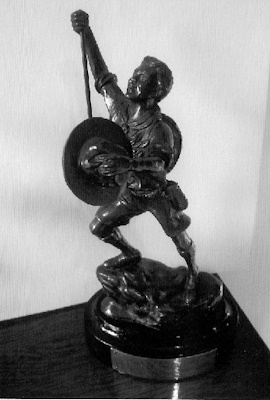
(Anne Counsell)
The timing of Cecil Turner’s retirement from the Scouts and the award of his medal in 1932 was probably no coincidence – he married that summer. The couple had three children – a son, Francis, born the following year, and twins Richard and Anne in 1935. Camping evidently remained in his blood as his daughter remembers the family camping holidays, still at Eastnor Castle.[20]
As already indicated in the 1911 census, he was a man of ‘private means’ – his father had left him a portfolio of properties throughout the area and he lived from their rents. Although by nature ‘a very private person’, he was also very community-minded, being governor of Barton Road Junior School and Queen Margaret Primary School, secretary of Tewkesbury Consolidated Charities, ex-secretary of Tewkesbury YMCA and also serving as Conservative member of Tewkesbury Town Council for 9 years. One of Sky Turner’s other main interests was fishing – he was a life-member of Tewkesbury Popular Angling Association in recognition of his services as president and treasurer there. It was his ‘private means’ that had allowed him to devote so much time to all these activities.
His great love was the works of Charles Dickens: he ran Tewkesbury’s ‘Dickens Fellowship’, to which he belonged from 1919 until his death forty years later, organising plays at the Town Hall. Performances were also carried out for the poor at the Workhouse – as he was also chairman of the Poor Law Relief Committee. To identify themselves, he encouraged the Dickens Fellowship members to wear Charles Dickens’s favourite red geranium button-hole flower that was often worn by Dickens himself.[21] He also met a descendant of Charles Dickens, Mrs. Elaine Waley (née Dickens) at a Dickens Conference in 1957.
When he died in 1959, still living at 11 Church Street, his obituary stated that “local people found him a willing organiser of bazaars and helper at fetes. In some ways Mr. Turner was a typical Edwardian with a passionate interest in such hobbies as ornithology and butterfly collecting.” It concluded, “a part of old Tewkesbury may be said to have passed away.”[22]
References
- Throughout this period Tewkesbury was not a district, but part of Cheltenham District, and the full title of the Group was 2nd Tewkesbury (18th Cheltenham).
- Cecil James Turner was born in early 1888, the son of Frederick R. Turner and his mother Sarah Ann who died soon after his birth. In 1901 he was living with his grandparents: James Turner was landlord of the Plough Inn, Barton Street. In the 1911 census his occupation was “private means”.
- Lord Baden-Powell (1857-1941) fought in the Boer War, successfully defending Mafeking. In doing this, he trained boys to act as military scouts. That experience inspired him, to found the Boy Scout Movement in 1907.
- The Princess was a granddaughter of Queen Victoria whose husband, Alexander, became Governor General of Canada.
- Whit Monday: Whitsuntide as the Christian festival comprising the days around and including the festival of Pentecost. The actual date depended on the varying date of Easter. In 1871 a ‘Bank Holiday’ was added on the Monday. This has now been replaced by the Spring Bank Holiday usually held on the last Monday of May.
- Grandson of Queen Victoria (1883-1938).
- Empire Day was celebrated on 24 May, Queen Victoria’s birthday, from 1902 to 1958.
- Today part of the Vineyards.
- For more information, see Sam Eedle, ‘The Abbey Boys in the Terriers’, THS Bulletin 13, 2004.
- For more information see Clementine De Leender , ‘Memoirs of a Teenage Belgian Refugee in Tewkesbury during World War I’, THS Bulletin 15, 2006.
- Voluntary Aid Detachment – local volunteer nurses who staffed a hospital set up in a large mansion, such as Mitton Manor, to treat wounded soldiers. It was under the command of a local doctor, Dr. Devereux.
- In1909, King Edward VII granted the award of the King’s Scout Badge as the highest achievement award for Boy Scouts on the recommendation of Baden-Powell himself.
- Henry Crisp was born in 1899 at 7 Gravel Walk.
- Respectively the future King Edward VIII and Lord Baden-Powell.
- Singlestick: also known as ‘cudgels’, used a wooden stick as a weapon. It began as a way of training soldiers in the use of swords.
- Poor Law Institution: this refers to the retirement complex now known as Shephard’s Mead on the Gloucester Road. From 1793 to 1929 it was officially known as the Workhouse where the poor worked in order to exist. However, after the Great War, it mainly catered for the elderly poor.
- Lord Somers was District Commissioner of Hereford and later Chief Scout on the death of Baden-Powell in 1941.
- Born in 1899 in Hinckley, Leicestershire, he lived with his uncle, carpenter Fred Howell of Folly Gardens.
- Sam Eedle first became interested in ‘Sky’ Turner when researching his article ‘The Abbey Boys in the Terriers’, published in THS Bulletin 13 (2004).
- Memories courtesy of daughter, Anne Counsell, interviewed by the author, 2003 & 2009.
- Extract from Dombey and Son: “A double knock announces the arrival of the Major, who is gorgeous too, and wears a whole geranium in his button-hole, and has his hair curled tight and crisp, as well the Native knows. ‘Dombey!’ says the Major, putting out both hands, ‘how are you?’”. A picture of ‘Sky’ Turner, with Dickensian connections, used to hang in the Hop Pole Hotel.
- Tewkesbury Register, 17 July 1959.
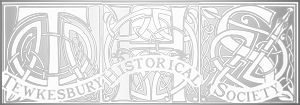
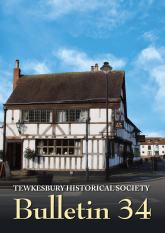
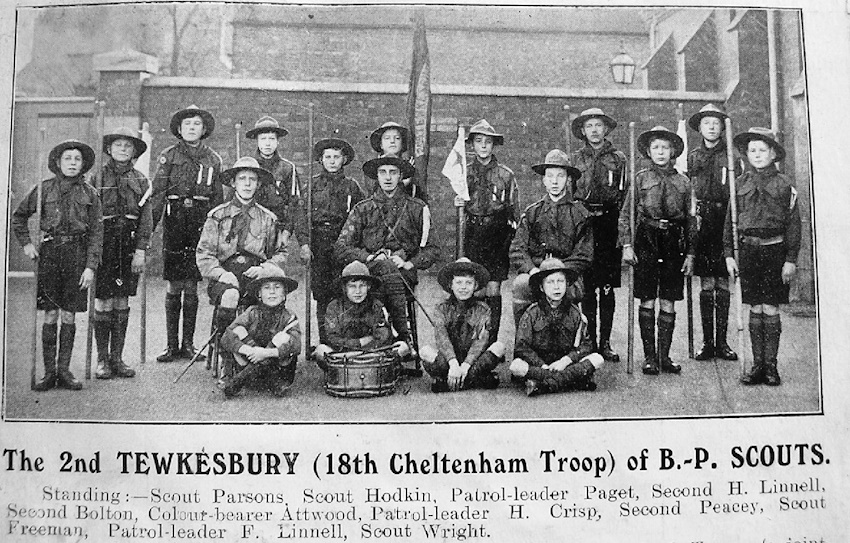
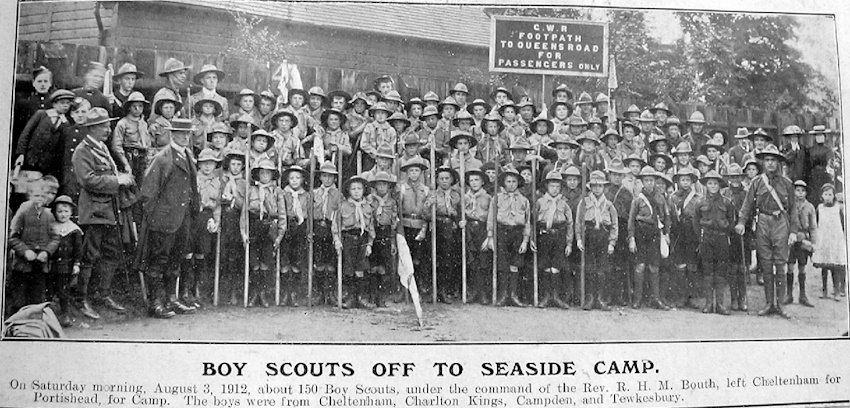
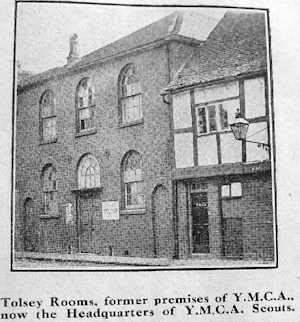
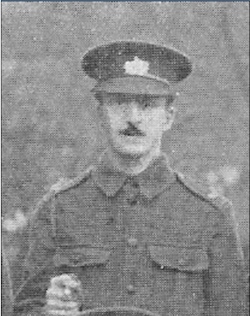
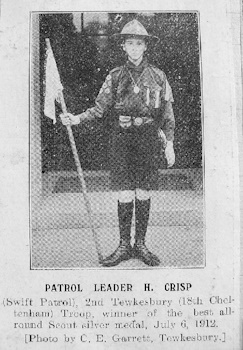
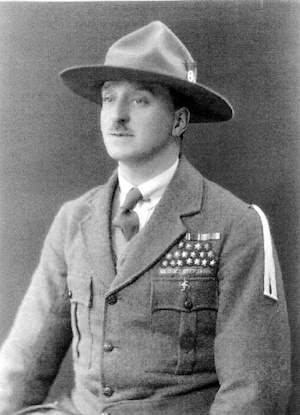
Comments